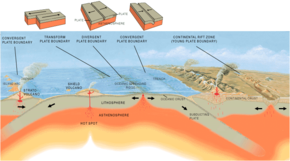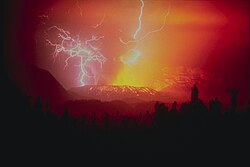প্ৰকৃতি: বিভিন্ন সংশোধনসমূহৰ মাজৰ পাৰ্থক্য
দিব্য দত্ত (আলোচনা | বৰঙণি) No edit summary |
দিব্য দত্ত (আলোচনা | বৰঙণি) |
||
| 23 নং শাৰী: | 23 নং শাৰী: | ||
==পৃথিৱী== |
==পৃথিৱী== |
||
[[File:The Earth seen from Apollo 17.jpg|thumb|left|১৯৭২ চনত এপল' ১৭ মহাকাশ যানে তোলা পৃথিৱীৰ চিত্ৰ।]] |
[[File:The Earth seen from Apollo 17.jpg|thumb|left|১৯৭২ চনত এপল' ১৭ মহাকাশ যানে তোলা পৃথিৱীৰ চিত্ৰ।]] |
||
পৃথিৱী হৈছে জীৱন সম্ভৱ হোৱা বৰ্তমানলৈকে জনা একমাত্ৰ [[গ্ৰহ]], আৰু ইয়াৰ প্ৰাকৃতিক বৈশিষ্টবোৰ বহুতো বৈজ্ঞানিক অনুসন্ধানৰ গুৰুত্বপূৰ্ণ বিষয়। ই [[সৌৰজগত]]ত তৃতীয় গ্ৰহ; ই আটাইতকৈ ডাঙৰ [[ভূত্বকীয় গ্ৰহ]] (terrestrial planet) আৰু ই পঞ্চম বৃহৎ গ্ৰহ। ইয়াৰ আটাইতকৈ বৈশিষ্টপূৰ্ণ জলবায়ু হৈছে ইয়াৰ দুই মেৰু অঞ্চল, দুটা তুলনামূলক ভাবে [[ |
পৃথিৱী হৈছে জীৱন সম্ভৱ হোৱা বৰ্তমানলৈকে জনা একমাত্ৰ [[গ্ৰহ]], আৰু ইয়াৰ প্ৰাকৃতিক বৈশিষ্টবোৰ বহুতো বৈজ্ঞানিক অনুসন্ধানৰ গুৰুত্বপূৰ্ণ বিষয়। ই [[সৌৰজগত]]ত তৃতীয় গ্ৰহ; ই আটাইতকৈ ডাঙৰ [[ভূত্বকীয় গ্ৰহ]] (terrestrial planet) আৰু ই পঞ্চম বৃহৎ গ্ৰহ। ইয়াৰ আটাইতকৈ বৈশিষ্টপূৰ্ণ জলবায়ু হৈছে ইয়াৰ দুই মেৰু অঞ্চল, দুটা তুলনামূলক ভাবে [[শীতোষ্ণ]] অঞ্চল, আৰু এটা বহল [[অক্ষীয়]] নাতিশীতোষ্ণ আৰু অৰ্ধ নাতিশীতোষ্ণ অঞ্চল।<ref> |
||
{{cite web |
{{cite web |
||
|url=http://www.blueplanetbiomes.org/climate.htm |
|url=http://www.blueplanetbiomes.org/climate.htm |
||
| 50 নং শাৰী: | 50 নং শাৰী: | ||
After the initial sequence of rocks has been deposited, the rock units can be [[deformation (mechanics)|deformed]] and/or [[metamorphism|metamorphosed]]. Deformation typically occurs as a result of horizontal shortening, [[extension (geology)|horizontal extension]], or side-to-side ([[strike-slip]]) motion. These structural regimes broadly relate to [[convergent boundary|convergent boundaries]], [[divergent boundary|divergent boundaries]], and [[transform boundary|transform boundaries]], respectively, between [[plate tectonics|tectonic plates]]. |
After the initial sequence of rocks has been deposited, the rock units can be [[deformation (mechanics)|deformed]] and/or [[metamorphism|metamorphosed]]. Deformation typically occurs as a result of horizontal shortening, [[extension (geology)|horizontal extension]], or side-to-side ([[strike-slip]]) motion. These structural regimes broadly relate to [[convergent boundary|convergent boundaries]], [[divergent boundary|divergent boundaries]], and [[transform boundary|transform boundaries]], respectively, between [[plate tectonics|tectonic plates]]. |
||
==তথ্য সংগ্ৰহ== |
==তথ্য সংগ্ৰহ== |
||
{{Reflist}} |
{{Reflist}} |
||
06:03, 8 November 2019ৰ সংস্কৰণ
ব্যাপক অৰ্থত প্ৰকৃতি (ইংৰাজী: Nature) বুলিলে প্ৰাকৃতিক, ভৌতিক বা বস্তুতাত্বিক পৃথিৱী বা বিশ্বব্ৰহ্মাণ্ডক বুজায়। "প্ৰকৃতি" শব্দই ভৌতিক পৃথিৱীত ঘটি থকা পৰিঘটনাবোৰ, লগতে জীৱনক নিৰ্দেশ কৰে। প্ৰকৃতিৰ অধ্যয়ন বিজ্ঞানৰ এটা বৃহৎ অধ্যায়। যদিও মানুহৰ কামবোৰ প্ৰাকৃতিক পৰিঘটনাৰ পৰা পৃথক বুলি ভবা হয়, তথাপি মানুহো প্ৰকৃতিৰে এটা অংগ।
প্ৰকৃতিৰ ইংৰাজী nature শব্দটো লেটিন শব্দnaturaৰ পৰা আহৰণ কৰা হৈছে, ইয়াৰ অৰ্থ হৈছে "essential qualities, innate disposition", আৰু অতীজতে ইয়াৰ আক্ষৰিক অৰ্থ আছিল "জন্ম (birth)"। Natura হৈছে গ্ৰীক শব্দ physis (φύσις)ৰ লেটিন অনুবাদ। ই প্ৰকৃততে উদ্ভিদ, প্ৰাণী আদিৰ অন্তৰ্নিহিত বৈশিষ্ট আৰু পৃথিৱীৰ অন্য বৈশিষ্টৰ সৈতে সম্পৰ্কীত আছিল।[1][2] সামগ্ৰকভাবে প্ৰকৃতিৰ ধাৰণাটোত, ভৌতিক বিশ্বব্ৰহ্মাণ্ডক বুজায়।[3] "ভৌতিক" শব্দৰ ক্ষেত্ৰত দেখা যায় যে ১৫ শতিকাৰ মাজভাগত ইয়াৰ সমাৰ্থক হিচাপে "প্ৰাকৃতিক" শব্দটো ব্যৱহাৰ কৰা হৈছিল।
বৰ্তমান প্ৰকৃতি শব্দ বিশেষকৈ ভূগোল আৰু বন্য জীৱন বুজাবলৈ ব্যৱহাৰ কৰা হয়। জীৱিত উদ্ভিদ আৰু প্ৰাণীৰ সাধাৰণ বৈশিষ্ট বুজাবলৈও প্ৰকৃতি শব্দৰ ব্যৱহাৰ কৰা হয়। কেতিয়াবা পৃথিৱীৰ কোনো বস্তুৰ স্থিতি অথবা পৰিবৰ্তন বুজাবলৈও ইয়াক ব্যৱহাৰ কৰা হয়, যেনে বতৰ, পৃথিৱীৰ ভূগোল আদি। ইয়াক প্ৰায়ে "প্ৰাকৃতিক পৰিৱেশ" বা বন্য জীৱন—বন্য প্ৰাণী, শিল, হাবি−বননি, আৰু সাধাৰণতে মানুহৰ হস্তক্ষেপ নথকা সকলো বস্তুকে বুজায়। উদাহৰণ স্বৰূপে উদ্যোগত উৎপাদিত সামগ্ৰীসমূহ আৰু মানুহৰ অৰিহনা থকা বস্তুসমূহক প্ৰকৃতিৰ অংশ হিচাপে ধৰা নহয়। পৰম্পৰাগত ধাৰণাত প্ৰাকৃতিক বস্তু আৰু কৃত্ৰিম বস্তুৰ স্পষ্ট পাৰ্থক্যৰ ব্যখ্যা দেখিবলৈ পোৱা যায়, মানুহৰ দ্বাৰা নিৰ্মিত বা উৎপাদিত বস্তু সমূহক কৃত্ৰিম বুলি গণ্য কৰা হয়। কিছুমান বিশেষ পৰিস্থিতিত প্ৰাকৃতিক শব্দটো অপ্ৰাকৃতিক বা অতিপ্ৰাকৃতিকৰ পৰা পাৰ্থক্য দেখুৱাবলৈও ব্যৱহাৰ কৰা হয়।
পৃথিৱী

পৃথিৱী হৈছে জীৱন সম্ভৱ হোৱা বৰ্তমানলৈকে জনা একমাত্ৰ গ্ৰহ, আৰু ইয়াৰ প্ৰাকৃতিক বৈশিষ্টবোৰ বহুতো বৈজ্ঞানিক অনুসন্ধানৰ গুৰুত্বপূৰ্ণ বিষয়। ই সৌৰজগতত তৃতীয় গ্ৰহ; ই আটাইতকৈ ডাঙৰ ভূত্বকীয় গ্ৰহ (terrestrial planet) আৰু ই পঞ্চম বৃহৎ গ্ৰহ। ইয়াৰ আটাইতকৈ বৈশিষ্টপূৰ্ণ জলবায়ু হৈছে ইয়াৰ দুই মেৰু অঞ্চল, দুটা তুলনামূলক ভাবে শীতোষ্ণ অঞ্চল, আৰু এটা বহল অক্ষীয় নাতিশীতোষ্ণ আৰু অৰ্ধ নাতিশীতোষ্ণ অঞ্চল।[4] Precipitation varies widely with location, from several metres of water per year to less than a millimetre. 71 percent of the Earth's surface is covered by salt-water oceans. The remainder consists of continents and islands, with most of the inhabited land in the Northern Hemisphere.
Earth has evolved through geological and biological processes that have left traces of the original conditions. The outer surface is divided into several gradually migrating tectonic plates. The interior remains active, with a thick layer of plastic mantle and an iron-filled core that generates a magnetic field. This iron core is composed of a solid inner phase, and a fluid outer phase. Convective motion in the core generates electric currents through dynamo action, and these, in turn, generate the geomagnetic field.
The atmospheric conditions have been significantly altered from the original conditions by the presence of life-forms,[5] which create an ecological balance that stabilizes the surface conditions. Despite the wide regional variations in climate by latitude and other geographic factors, the long-term average global climate is quite stable during interglacial periods,[6] and variations of a degree or two of average global temperature have historically had major effects on the ecological balance, and on the actual geography of the Earth.[7][8]
Geology
Geology is the science and study of the solid and liquid matter that constitutes the Earth. The field of geology encompasses the study of the composition, structure, physical properties, dynamics, and history of Earth materials, and the processes by which they are formed, moved, and changed. The field is a major academic discipline, and is also important for mineral and hydrocarbon extraction, knowledge about and mitigation of natural hazards, some Geotechnical engineering fields, and understanding past climates and environments.
Geological evolution

The geology of an area evolves through time as rock units are deposited and inserted and deformational processes change their shapes and locations.
Rock units are first emplaced either by deposition onto the surface or intrude into the overlying rock. Deposition can occur when sediments settle onto the surface of the Earth and later lithify into sedimentary rock, or when as volcanic material such as volcanic ash or lava flows, blanket the surface. Igneous intrusions such as batholiths, laccoliths, dikes, and sills, push upwards into the overlying rock, and crystallize as they intrude.
After the initial sequence of rocks has been deposited, the rock units can be deformed and/or metamorphosed. Deformation typically occurs as a result of horizontal shortening, horizontal extension, or side-to-side (strike-slip) motion. These structural regimes broadly relate to convergent boundaries, divergent boundaries, and transform boundaries, respectively, between tectonic plates.
তথ্য সংগ্ৰহ
- ↑ An account of the pre-Socratic use of the concept of φύσις may be found in Naddaf, Gerard (2006) The Greek Concept of Nature, SUNY Press. The word φύσις, while first used in connection with a plant in Homer, occurs very early in Greek philosophy, and in several senses. Generally, these senses match rather well the current senses in which the English word nature is used, as confirmed by Guthrie, W.K.C. Presocratic Tradition from Parmenides to Democritus (volume 2 of his History of Greek Philosophy), Cambridge UP, 1965.
- ↑ The first known use of physis was by Homer in reference to the intrinsic qualities of a plant: ὣς ἄρα φωνήσας πόρε φάρμακον ἀργεϊφόντης ἐκ γαίης ἐρύσας, καί μοι φύσιν αὐτοῦ ἔδειξε. (So saying, Argeiphontes [=Hermes] gave me the herb, drawing it from the ground, and showed me its nature.) Odyssey 10.302–03 (ed. A.T. Murray). (The word is dealt with thoroughly in Liddell and Scott's Greek Lexicon Archived March 5, 2011, at the Wayback Machine.) For later but still very early Greek uses of the term, see earlier note.
- ↑ Isaac Newton's Philosophiae Naturalis Principia Mathematica (1687), for example, is translated "Mathematical Principles of Natural Philosophy", and reflects the then-current use of the words "natural philosophy", akin to "systematic study of nature"
- ↑ "World Climates". Blue Planet Biomes. http://www.blueplanetbiomes.org/climate.htm। আহৰণ কৰা হৈছে: September 21, 2006.
- ↑ "Calculations favor reducing atmosphere for early Earth". Science Daily. September 11, 2005. https://www.sciencedaily.com/releases/2005/09/050911103921.htm। আহৰণ কৰা হৈছে: January 6, 2007.
- ↑ "Past Climate Change". U.S. Environmental Protection Agency. http://www.epa.gov/climatechange/science/pastcc.html। আহৰণ কৰা হৈছে: January 7, 2007.
- ↑ Hugh Anderson; Bernard Walter (March 28, 1997). "History of Climate Change". NASA. Archived from the original on January 23, 2008. https://web.archive.org/web/20080123130745/http://vathena.arc.nasa.gov/curric/land/global/climchng.html। আহৰণ কৰা হৈছে: January 7, 2007.
- ↑ Weart, Spencer (June 2006). "The Discovery of Global Warming". American Institute of Physics. http://www.aip.org/history/climate/। আহৰণ কৰা হৈছে: January 7, 2007.




